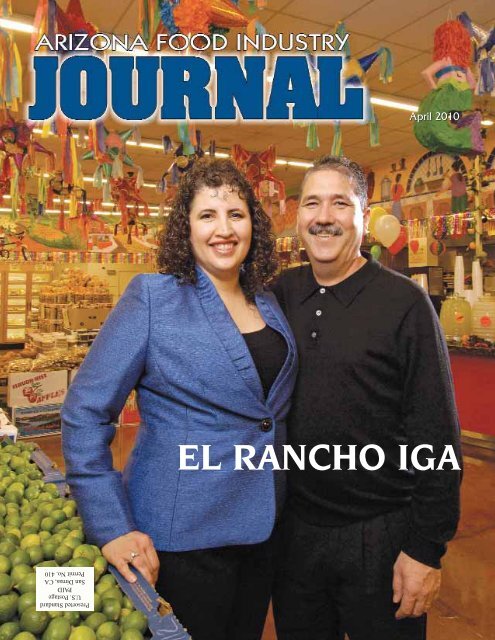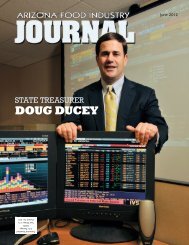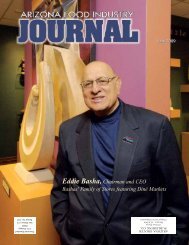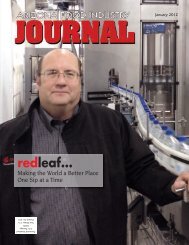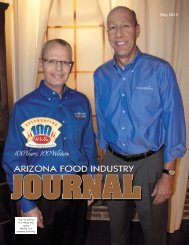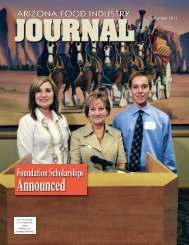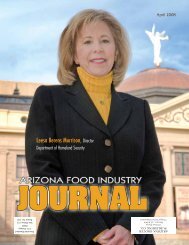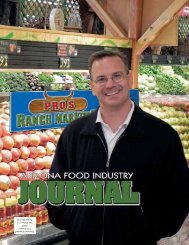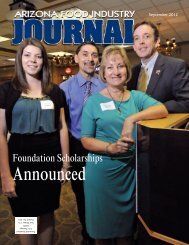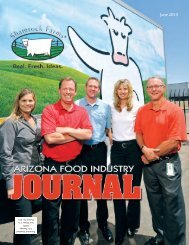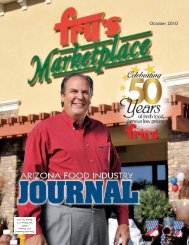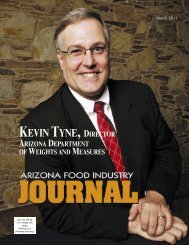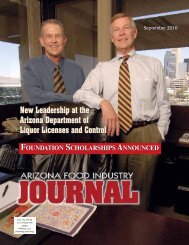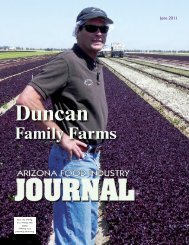EL RANCHO IGA - Arizona Food Marketing Alliance
EL RANCHO IGA - Arizona Food Marketing Alliance
EL RANCHO IGA - Arizona Food Marketing Alliance
Create successful ePaper yourself
Turn your PDF publications into a flip-book with our unique Google optimized e-Paper software.
April 2010<br />
<strong>EL</strong> <strong>RANCHO</strong> <strong>IGA</strong><br />
Presorted Standard<br />
U.S. Postage<br />
PAID<br />
San Dimas, CA<br />
Permit No. 410
ARIZONA FOOD INDUSTRY<br />
JOURNAL<br />
JOURNAL<br />
APRIL 2010<br />
BOARD OF DIRECTORS<br />
OFFICERS<br />
Ron Parucki, Fry’s <strong>Food</strong> Stores – Chairman<br />
Jim Tooms, IGW L.L.C. - 1st Vice Chairman<br />
Jeff Nelson, Co-Sales Company - 2nd Vice Chairman<br />
Doug Sanders, Sprouts Farmers Market - 3rd Vice Chairman<br />
Geoff Stickler, Express <strong>Food</strong>s – Treasurer<br />
Don Olsen, Olsens <strong>IGA</strong> – Past Chairman<br />
DIRECTORS<br />
Frank Cannistra, Safeway<br />
Joe Cotroneo, Crescent Crown Distributing<br />
Shane Dorcheus, Albertsons L.L.C.<br />
Louis Diab, Circle K<br />
Ray Kruckner, 7-Eleven<br />
Mark Miller, Hensley<br />
Randy Ong, Sunflower Farmers Market<br />
Mike Provenzano, Ranch Markets<br />
T.J. Shope, Shope’s <strong>IGA</strong><br />
Bette Taylor, <strong>Food</strong>town <strong>IGA</strong><br />
Tim Thomas, The <strong>Arizona</strong> Republic<br />
PRESIDENT - TIM MCCABE<br />
AFMA STAFF<br />
Debbie Roth - General Manager<br />
Raynetta Hughes - Administrative Coordinator<br />
Paul Bancroft-Turner - <strong>Marketing</strong> Coordinator<br />
ACR STAFF<br />
Dan Tennessen - Director<br />
Greg Colyar - Field Manager<br />
Judy Lettow - Customer Care/Office Manager<br />
JOURNAL STAFF<br />
Debbie Roth - Editor<br />
Lisa Schnebly Heidinger - Feature Writer<br />
Jim Marshall - Photographer<br />
Layton Printing - Printer<br />
JMT Graphics - Graphic Design<br />
CONTENTS<br />
FEATURES<br />
Alaskan Brewing Company ................................................18<br />
<strong>EL</strong> Rancho <strong>IGA</strong>..................................................................14<br />
COLUMNS<br />
Around <strong>Arizona</strong> History ........................................................8<br />
Legislative Insight ................................................................4<br />
www.commentary ............................................................10<br />
DEPARTMENTS<br />
Industry Calendar ..............................................................21<br />
Names in the News ..........................................................20<br />
WORTH A LOOK<br />
AFMA Board Member Profile ..............................................21<br />
We-Ko-Pa... WOW!..........................................................12<br />
ADVERTISERS<br />
ACR ................................16<br />
ASU ................................22<br />
Alaskan Brewing ................19<br />
APEX ................................22<br />
<strong>Arizona</strong> Lottery ....................5<br />
Blue Bunny ........................22<br />
Cox Communications ..........17<br />
Crescent Crown ..................2<br />
Dr. Pepper/Snapple............11<br />
Dreyer’s ..............................9<br />
Garvin Promotions ..............23<br />
MillerCoors........................24<br />
ARIZONA FOOD MARKETING ALLIANCE<br />
120 E. PIERCE ST., PHOENIX, AZ 85004<br />
602.252.9761 • FAX: 602.252.9021<br />
DROTH@AFMAAZ.ORG<br />
WWW.AFMAAZ.ORG<br />
ANNUAL SUBSCRIPTION $50<br />
ON THE COVER<br />
<strong>EL</strong> <strong>RANCHO</strong> <strong>IGA</strong> Owners<br />
Elizabeth and Jorge Rascon.
Legislative Insight<br />
(Editors Note: In response to a member's suggestion to engage<br />
Legislators’ thoughts and expertise on issues impacting the <strong>Food</strong><br />
Industry, what follows is the third in a series of questions asked<br />
and answered by the members of the <strong>Arizona</strong> State Legislature.)<br />
THE JOURNAL: Being a rancher and representing<br />
a more rural area of <strong>Arizona</strong> how are the challenges<br />
different in this struggling economy from those in<br />
Maricopa County?<br />
Besides the budget issue, what other goals do you<br />
want to accomplish in this session? Are any of these<br />
beneficial to existing businesses in <strong>Arizona</strong>?<br />
Senator Steve Pierce:<br />
Everyone is struggling now in this country. It is a bad time in<br />
history. I see people suffering in Maricopa County and in Yavapai<br />
County. I think that when the economy lives on growth like ours<br />
does, it is more vulnerable to the downturns. Maricopa is<br />
probably hit worse than the rural counties since that is where<br />
most of the growth is. Yavapai has growth but in this and in other<br />
recessions it seems like it may go flat and slow growth but it does<br />
not stop like in Phoenix. People in the rural areas seem to be able<br />
to handle the adversity and display more resilience in their ability<br />
to get by in these hard times. It hurts everywhere but rural areas<br />
are not as bad.<br />
Here at the Senate, the budget is the main focus for me. Many<br />
members focus on bills and issues but I see the State teetering on<br />
the edge of financial ruin. It is a bad situation that has members<br />
not paying attention to the big picture – the economy. My first<br />
constitutional obligation is to pass a balanced budget. Not an easy<br />
task in this economy, but it is possible. We need to get this State<br />
to become a business friendly State that has less government, less<br />
regulation, less taxes and more open to good industry moving<br />
here so we can grow our way out of this mess faster. We need to<br />
restructure our tax code and be on the cutting edge of a modern,<br />
business friendly State. We need to reform the laws and rules that<br />
restrict business and remove regulations on them so they can<br />
come to <strong>Arizona</strong> to grow and prosper. Jobs are leaving California<br />
and going to Texas. We need to stop them and get them to make<br />
<strong>Arizona</strong> their home. We have as much to offer as any other state<br />
and then more. We should be soliciting companies to move here<br />
by promoting ourselves and what we have to offer. We should be<br />
advertizing more and get this State in the forefront of the nation;<br />
and our State should become a safe haven from the rest of the<br />
nation. Texas is doing this now and we need to make hard<br />
decisions that will improve everyone’s lifestyle. We can do it! ◆<br />
Page 4 • <strong>Arizona</strong> <strong>Food</strong> Industry Journal • April 2010<br />
Senator Steve Pierce<br />
A third-generation <strong>Arizona</strong>n, Steve Pierce was born in Phoenix in 1950. He moved to Prescott<br />
while in grade school when his dad, Delbert, acquired the first of several ranches now known as the<br />
Las Vegas Ranch. He was raised on the family ranch where he learned the value of hard work at a<br />
young age. A graduate of Prescott High and the University of <strong>Arizona</strong>, Steve has continued the<br />
family tradition of ranching. Steve and his wife Joan have been married for 35 years. They raised<br />
their four children in Prescott, and are now blessed with four grandchildren.<br />
He graduated from the University of <strong>Arizona</strong> with a bachelor’s degree in Animal Science. His<br />
family has been ranching in <strong>Arizona</strong> since 1915, and Steve himself has five decades of experience<br />
working as a rancher. Steve has served in various cattle and agriculture organizations, both locally<br />
and nationwide, such as the National Cattlemen’s Beef Board, the US Meat Export Federation, and<br />
the <strong>Arizona</strong> Beef Council. In addition, Steve has served on the Board of Directors of County Bank,<br />
the Anasazi Foundation and the Central <strong>Arizona</strong> Partnership. Steve is active with the Yavapai<br />
County Republican Party, where he was elected as Chairman, and has been elected to the State<br />
Executive Committee for the <strong>Arizona</strong> Republican Party for the last five years.<br />
Steve has always been an excellent steward of the land for which he is responsible. He was<br />
recognized for his efforts in 1983 when the <strong>Arizona</strong> Section of the Society for Range Management<br />
named Steve and his father Delbert “Range Managers of the Year”.
INDUSTRY & GOVERNMENT<br />
…. a summary of the issues that affect your business.<br />
“Nearly all men can stand adversity, but if you want<br />
to test a man's character, give him power.”<br />
—Abraham Lincoln<br />
CITY ISSUES<br />
City of Mesa Proposes Security Plan for<br />
Convenience Stores<br />
The City of Mesa Police Department has put together a proposal<br />
that would significantly impact all convenience stores in Mesa. This<br />
plan is part of an initiative called Crime Prevention Through<br />
Environmental Design (CPTED).<br />
The City is focused on reducing crime in retail outlets with special<br />
attention on robberies and beer thefts. The proposed measures include:<br />
ballards in parking lots, special lighting, nets on beer displays and<br />
locking beer coolers during certain hours.<br />
"Our convenience stores already have detailed security plans. Top<br />
priority has always been the safety of customers and employees. This<br />
proposal would add significant cost to all stores. The biggest impact<br />
would be to the 11 plus small independents in Mesa that are struggling<br />
now to survive in this tough economy. The cost of this proposal could<br />
put many of them out of business," said Tim McCabe president of the<br />
<strong>Arizona</strong> <strong>Food</strong> <strong>Marketing</strong> <strong>Alliance</strong>. "We will continue to work with the<br />
Mesa Police Department to find a fair resolution. Reducing crime in our<br />
stores is very important to us as well and we look forward to partnering<br />
with the City in any way possible."<br />
"We compliment Mesa on the overall CPTED plan."<br />
NATIONAL ISSUES<br />
House and Senate Must Reconcile<br />
Jobs Legislation Differences<br />
On March 10 the Senate passed along a 62-36 vote $31 billion in<br />
temporary tax breaks along with new permanent penalties on<br />
businesses that try to avoid taxes using transactions that lack any<br />
underlying “economic substance.” H.R. 4213 would extend more than<br />
40 tax breaks that expired at the end of 2009 through 2010 including<br />
a 15-year cost recovery provision for improvements to restaurants and<br />
retailers. The overall bill included another extension of federal<br />
unemployment insurance benefits, tax credits to subsidize the cost of<br />
COBRA health insurance premiums for displaced workers, and a<br />
temporary change in pension funding rules to ease some of the<br />
financial strain on employers due to the drop in pension values as the<br />
stock market softened. Eight Republicans voted for cloture on the<br />
bill including new Senator Scott Brown (R-MA).<br />
The bill was amended significantly by the Senate since the House<br />
passed it in December 2009, therefore it’s anticipated that the<br />
legislation will now move to conference between the House and<br />
Senate, which would be a rarity for tax bills in recent years. Often the<br />
House will simply accept and pass the Senate’s changes. The House<br />
Ways and Means Committee is now under the leadership of Chairman<br />
Sander Levin (D-MI) after embattled Chairman Charlie Rangel (D-<br />
NY) stepped aside amid an ethics investigation. House Democrats<br />
are also planning to move forward on small business tax legislation<br />
that would among other things, eliminate capital gains taxes on sales<br />
of shares in start up firms and smaller companies.<br />
White House and Unions Remain<br />
Optimistic About EFCA:<br />
The White House and organized labor have not given up on seeking<br />
enactment of the Employee Free Choice Act (EFCA). Vice President<br />
Joe Biden recently told the AFL-CIO at their winter meeting in<br />
Orlando, Florida, that the Obama Administration will still be able to<br />
push through the union-organizing “card check” bill despite the fact<br />
that Democrats have lost their 60-seat super-majority in the Senate.<br />
Biden offered few specifics on how the White House would jump<br />
start the EFCA legislation (H.R.1409 – S.560) which has seen no<br />
activity since its introduction early in 2009. Biden also made no<br />
mention of the failed attempt to get Senate approval of the nomination<br />
of pro-union lawyer Craig Becker to the National Labor Relations<br />
Board (NLRB). The Senate rejected Becker by a vote of 52 - 33.<br />
The employer community must not get too complacent over its<br />
successes so far on blocking EFCA and the Becker nomination.<br />
There is a legitimate concern that at the urging of big labor, Senate<br />
Majority Leader Harry Reid (D-NV) might be willing to schedule a<br />
vote on the EFCA bill as introduced knowing there are not 60 votes<br />
to move the legislation. After this “test vote”, Senator Reid in<br />
concert with Senator Tom Harkin (D-IA) could then unveil a<br />
compromise measure that would jettison the card check provisions<br />
while preserving the secret ballot, but would require “quickie”<br />
elections and grant union organizers access to the employer’s work<br />
site during normal business hours. The so-called new EFCA<br />
compromise would also feature mandatory binding arbitration if the<br />
union and the employer cannot reach an agreement on the first<br />
contract within 120 days. FMI and member companies need to<br />
remind key Senators that EFCA and any alternative compromises<br />
must be rejected.<br />
Page 6 • <strong>Arizona</strong> <strong>Food</strong> Industry Journal • April 2010
Another way in which to impose EFCA provisions on employers<br />
is through administrative rulemaking by the NLRB. Such a scenario<br />
would occur if President Obama were to make Craig Becker a “recess<br />
appointment” to the Board. This could happen as early as April,<br />
when Congress breaks for its Easter recess. Efforts are underway by<br />
various anti-EFCA coalitions to encourage Members of Congress to<br />
contact the White House in opposition to a Becker “recess<br />
appointment.” Becker’s background as Associate General Counsel of<br />
the Service Employees International Union (SEIU) and the numerous<br />
law review articles that he has written over the years clearly show he<br />
holds extreme views on how the National Labor Relations Act<br />
(NLRA) should be interpreted and how it can be changed without the<br />
need for any new legislation. For more information contact Ty<br />
Kelley, tkelley@fmi.org.<br />
Graying the Supermarket, Artfully<br />
rehydrate and replenish, and highly visible displays of cold beverages<br />
and protein bars or shakes might click. Or some other healthful foods<br />
on displays (or a dietitian’s presentation) could help these shoppers<br />
better understand the interplay between exercise, foods and<br />
beverages at their age and their intensity levels. This would promote<br />
their self-improvement and their active lifestyles, and keep the<br />
supermarket in the mix.<br />
Indeed, Pennsylvania Governor Edward G. Rendell proclaimed (March<br />
8-12) as Older Pennsylvanians’ Nutrition Awareness Week. “Eating<br />
properly and getting adequate exercise can go a long way to maintaining<br />
good health,” he said. The state’s Department of Aging and the 52 Area<br />
Agencies on Aging offer information and programs on proper nutrition<br />
for older adults. With so many motivated Boomers (and seniors), and<br />
with institutionalized programs such as this around, supermarkets need<br />
to know their 55+-shopper ebb and flow – in order to reach more of<br />
them more powerfully, and to remain an essential part of their fitness<br />
and health equation.<br />
Latino-Grocery Boom likely to Slow as<br />
Second-Generation Shoppers Surge<br />
A growth boom in the Latino grocery-store sector could be poised<br />
for a slowdown in the next decade. The development surge is set to level<br />
off as population changes make those stores less critical to Latino<br />
shoppers, industry experts are predicting.<br />
Colorado has been a focus of the industry’s ravenous appetite for<br />
expansion. Eleven large-format Latino-oriented groceries — owned by<br />
Avanza, Azteca and Rancho Liborio — have opened in the state since<br />
2003. Dozens more are operating in California, <strong>Arizona</strong>, Nevada and<br />
other states with large Latino populations.<br />
If supermarket managers focus on the shoppers in their aisles – not<br />
just the conditions of their shelves – they’d know the kinds of<br />
customers that frequent their stores, the times and days they tend to<br />
shop, and the parts of the store that please or irk them most.<br />
With these insights, a ‘quick-change artist’ store could satisfy shoppers<br />
more by suiting their rhythms and preferences. It doesn’t require<br />
operational drama on the selling floor to suit a group like the 55+, for<br />
example. How about ‘60s music on the speaker system when Boomers<br />
are most populous? Might it lengthen their store visits, and help make<br />
them more receptive to many kinds of offers?<br />
Supermarkets that adopt lessons from gyms whose membership has<br />
grayed will be quicker to bring more shopping pleasure to Boomers.<br />
Membership among adults 55 and older reached 10.5 million in 2008,<br />
up from 1.5 million in 1987, making them the fastest-growing<br />
segment of the health club population, the New York Times reported,<br />
citing annual surveys by the International Health, Racquet and<br />
Sportsclub Association.<br />
Clubs not only change the music at their busiest ‘gray’ times, they<br />
change the equipment and the regimens to suit the body conditions of<br />
most of 55+, rather than jacked young bodybuilders. Similarly,<br />
supermarkets could observe when their 55+ come in and adjust<br />
accordingly. If they’re coming from their gym workouts, they need to<br />
By offering bilingual signs, Spanish-speaking employees and<br />
food products from Latin American countries, the stores have been<br />
popular with Latino customers. But over the next decade, Latinos<br />
born in the United States will, for the first time, begin to outnumber<br />
foreign-born Latinos.<br />
U.S.-born Latinos are more culturally assimilated and less likely<br />
than their immigrant parents to embrace Latino grocery stores,<br />
analysts said. “The real growth in the Latino population is going to<br />
come from the second generation,” said David Morse, president of<br />
Los Angeles-based New American Dimensions, a multicultural<br />
marketing- research firm. “The first generation wants a culturally<br />
familiar shopping environment, and that’s why this (Latino) grocery<br />
sector has been so popular,” Morse said. “But the second generation<br />
can shop anywhere they want, so the comfort of a Hispanic grocery<br />
is no longer an issue.”<br />
A survey by New American Dimensions and the <strong>Food</strong> <strong>Marketing</strong><br />
Institute shows that foreign-born Latinos are about twice as likely as<br />
Latinos born in the U.S. to seek stores with Spanish-speaking<br />
employees, store signs in Spanish and Spanish-language advertising.<br />
Analysts said they expect Latino groceries to continue to grow, but<br />
not at the fast pace of the past decade.<br />
◆<br />
April 2010 • <strong>Arizona</strong> <strong>Food</strong> Industry Journal • Page 7
Around <strong>Arizona</strong> History<br />
“You need your food, you need your water, and you need your history!”<br />
What’s in a Name?<br />
Territorial Prescott and Governor<br />
Richard C. McCormick<br />
Richard Cunningham McCormick<br />
was a powerhouse and his lasting imprint on the<br />
community I call, home, Prescott, <strong>Arizona</strong>, endures<br />
to this day. He was born on May 23, 1832 in New<br />
York City and during a career that took him from<br />
New York to territorial <strong>Arizona</strong> and back, he served<br />
as the first Secretary and second Governor of<br />
<strong>Arizona</strong> Territory, three time Delegate to the U.S.<br />
House of Representatives from <strong>Arizona</strong> Territory,<br />
and as a Member of the U.S. House of<br />
Representatives from New York. McCormick's other<br />
accomplishments include service as a war<br />
correspondent during two different conflicts and<br />
creation of two <strong>Arizona</strong> newspapers.<br />
As a youngster McCormick suffered from poor<br />
health and Instead of enrolling in college, he was sent<br />
to Europe under the Victorian belief that travel could<br />
cure his ailments. There he became a war correspondent<br />
reporting on the Crimean War. When he returned to the<br />
U.S. the redheaded McCormick became the YMCA's<br />
corresponding secretary and edited Young Men's<br />
Magazine. In 1860, at the age of 28, McCormick<br />
became editor of the New York Evening Post. At the<br />
start of American Civil War, he went to front lines<br />
as a war correspondent.<br />
Meanwhile, he entered the political arena,<br />
identifying with the newly-created Republican party.<br />
He became a member of the Republican State<br />
Committee in 1860 where he worked on Abraham<br />
Lincoln's presidential campaign. In 1862, with<br />
President Lincoln ensconced in office and preoccupied<br />
with the Civil War, McCormick made an unsuccessful<br />
run for the U. S. House of Representatives. Though he<br />
lost his House race, Lincoln rewarded McCormick’s<br />
loyalty and nominated him to be Secretary of <strong>Arizona</strong><br />
Territory on March 7, 1863. Following confirmation,<br />
Page 8 • <strong>Arizona</strong> <strong>Food</strong> Industry Journal • April 2010<br />
By Jack L. August, Ph.D.<br />
McCormick journeyed with Governor John N.<br />
Goodwin's party to the newly formed territory.<br />
McCormick took his oath of office on December 29,<br />
1863 as part of the Navajo Springs ceremony that<br />
officially established <strong>Arizona</strong> Territory.<br />
Outside his official duties, McCormick established<br />
the <strong>Arizona</strong> Miner. The newspaper's first edition was<br />
printed on March 9, 1864 at Fort Whipple and began<br />
regular operations in Prescott on June 22, 1864.<br />
Naturally, McCormick's control of the newspaper<br />
aided his political career because he always received<br />
favorable press coverage. The paper also provided a<br />
forum for McCormick to share his vision with the<br />
people of <strong>Arizona</strong>. In 1868, following the territorial<br />
capitol's move to Tucson, for example, McCormick sold<br />
his property in Prescott and purchased an interest in<br />
the Weekly Arizonian. His association with the<br />
Arizonian continued till October 1, 1870 when the<br />
paper's editor withdrew political support for<br />
McCormick. McCormick's response was to repossess<br />
the paper's printing press and begin a new newspaper,<br />
the <strong>Arizona</strong> Citizen, on October 15, 1870.<br />
As Governor and Territorial Delegate McCormick<br />
was a leader in <strong>Arizona</strong> Territory's "Federal Ring."<br />
This group was a coalition of territorial officials and<br />
leading citizens that worked in a nonpartisan fashion<br />
to protect the lives and property of the territory's<br />
American population, establish law and order, and<br />
develop <strong>Arizona</strong>'s economic potential. To achieve their<br />
goals they crossed traditional political divides of the<br />
day, with Northern Republican governors appointing<br />
Southern Democrats and Hispanics to positions of<br />
leadership. The "Federal Ring" dominated territorial<br />
politics between 1863 and 1877 and though criticized<br />
by many, it succeeded in providing a territorial<br />
government that was relatively free of corruption and<br />
dishonesty. As Governor, McCormick opposed the<br />
policy of extermination of Indian groups and instead<br />
supported the idea of a reservation system.<br />
But McCormick’s most significant and lasting<br />
contribution was the naming of <strong>Arizona</strong>’s territorial<br />
Capitol, Prescott. The local Yavapai Indian name for<br />
the site was In-dil-chin-ar (pine woods). At first, the<br />
new Anglo-American population could not come to<br />
agreement on a name: Gimletville, Audobon, Aztlan,<br />
Goodwin City (for first sitting Governor, John<br />
Goodwin), Granite (due to its location on Granite<br />
Creek), and Fleuryville (for Judge Henry W. Fleury,<br />
who had his headquarters on the west side of Granite<br />
Creek) were a few that never gained traction. But as<br />
McCormick wrote to a friend on July 11, 1864, “Our<br />
new town is progressing finely. You must credit the<br />
name…to me.” McCormick, who had brought a<br />
considerable library with him to the Southwest, had<br />
recently completed reading William Hickling Prescott’s<br />
three volume-tome, The Conquest of Mexico and<br />
convinced his fellow citizens that the name was<br />
preferred over others because of the "Aztec memorial<br />
everywhere existing in this region and confirming the<br />
conclusions of the great American historian.”Though<br />
Prescott, the historian, was mistaken about the Aztec’s<br />
prehistoric reach into what is now central <strong>Arizona</strong>,<br />
McCormick nevertheless, embraced the historian’s<br />
conclusions and convinced settlers that “Prescott”was<br />
the ideal name. Indeed McCormick’s legacy is reflected<br />
in Prescott’s street names—Montezuma (Whiskey<br />
Row), Cortez, Marina, Alarcon-- are testaments to<br />
McCormick’s leadership and early influence in the<br />
territory. After a distinguished post-<strong>Arizona</strong> career in<br />
mining ventures and Republican politics, McCormick<br />
returned to New York where he died peacefully at his<br />
home on June 2, 1901.<br />
◆<br />
Dr. Jack L. August, Jr. is Professor of Practice in the History of Water Resource<br />
Development and Land Use in the American West in the College of Agriculture and Life<br />
Sciences at the University of <strong>Arizona</strong>. He also serves as Executive Director of the Barry<br />
Goldwater Center for the Southwest and is Visiting Scholar in Legal History at Snell & Wilmer<br />
L.L.P. He is a former Fulbright Scholar, National Endowment for the Humanities Research<br />
Fellow, and Pulitzer Prize nominee for his volume, Vision in the Desert: Carl Hayden and<br />
Hydropolitics in the American Southwest (Ft. Worth: TCU Press, 1999). Dr. August is the author<br />
of numerous books on the history of the New American West and has taught at the University<br />
of Houston, University of Northern British Columbia, and Northern <strong>Arizona</strong> University where<br />
his courses focused on the American West and environmental history.
April 2010 • <strong>Arizona</strong> <strong>Food</strong> Industry Journal • Page 9
www.commentary<br />
By Phil Hawkes<br />
FOOD RULES<br />
Michael Pollan has written a wonderful guidebook for eating better and<br />
healthier. His “<strong>Food</strong> Rules……An Eater’s Manual,” is informative, thought<br />
provoking, humorous and clever. And, you can read it in one sitting. The author<br />
has boiled down the complicated subject of food and eating to the following<br />
simple statements: “Eat food…..Not too much….Mostly plants.” And with<br />
those sage pieces of advice as his guardrails, he sought input from doctors,<br />
nurses, nutritionists, folklorists, mothers, grandmothers and great grandmothers<br />
to come up with a listing of food rules. He even invited the public’s input and<br />
received 2,500 more suggestions. The result was 64 simple rules for eating<br />
better. Here is a sampling of them. If some of the rules need more explanation<br />
for you……read the book! I must forewarn my food industry readers, many of<br />
the rules are not favorable towards our products or our item assortments.<br />
RULES ABOUT FOOD TO AVOID<br />
●<br />
●<br />
●<br />
●<br />
●<br />
●<br />
●<br />
●<br />
●<br />
●<br />
●<br />
●<br />
●<br />
“Don’t eat anything your great grandmother would not recognize as<br />
food.” If you don’t have a great grandmother, he suggests you borrow one.<br />
“Avoid foods with ingredients that a third grader cannot pronounce.”<br />
“Avoid foods that are pretending to be something they are not.”<br />
The perfect example is margarine. It is not butter.<br />
“Avoid foods you see advertised on television.” They are all<br />
processed oods.<br />
“Avoid foods with high fructose corn syrup.” They are all<br />
processed foods.<br />
“If it comes from a plant-eat it. If it was made in a plant-don’t.”<br />
Another processed food comment.<br />
“Avoid foods that have some form of sugar in its first three<br />
ingredients.” Do you know there are 40 types of sugar used in<br />
processed foods?<br />
“Don’t get your fuel from the same place your car does.”<br />
Those convenience stores are all processed foods.<br />
“It is not food if it is called by the same name in every language.”<br />
Think Big Mac or Cheetos.<br />
“It is not food if it came to you through your car window.” Enough said!<br />
“Don’t eat cereals that change the color of milk.”<br />
“The whiter the bread, the sooner you’ll be dead.”<br />
“Avoid foods with the word ‘lite’ or the terms ‘low-fat’ or ‘nonfat’ in<br />
their names.” Why, you ask? These terms were linked to food<br />
introduced in the 70s. The average male is seventeen pounds heavier<br />
and the average female, nineteen pounds heavier than they were in 1970.<br />
RULES ABOUT WHAT TO EAT<br />
●<br />
●<br />
●<br />
●<br />
“Eat <strong>Food</strong>.” Sounds obvious, but he means real food, not “edible<br />
foodlike substances.”<br />
“Eat well grown food from healthy soil.” He could have said eat only<br />
organic food, but that would be unfair to many great foods that just<br />
don’t qualify to be organic.<br />
“Eat mostly plants- especially leaves.”<br />
“Eat sweet foods as you find them in nature.” Consume the fruit,<br />
Page 10 • <strong>Arizona</strong> <strong>Food</strong> Industry Journal • April 2010<br />
●<br />
●<br />
●<br />
●<br />
●<br />
●<br />
●<br />
not the juice of it.<br />
“Eat foods predigested by bacteria or fungi.” Your digestive and<br />
immune systems will benefit from fermented foods like yogurt,<br />
sauerkraut, sourdough and soy sauce.<br />
“Eat more colors.” A pro-vegetable rule.<br />
“Eating what stands on one leg (mushrooms and plant foods) is better<br />
than eating what stands on two legs (fowl), which is better than eating<br />
what stands on four legs (cows and pigs).” An old Chinese proverb.<br />
“Eat animals that have themselves eaten well.”<br />
“Don’t overlook those oily little fishes.” A Dutch proverb proclaims<br />
that “ land with lots of herring can get by with few doctors." Never<br />
thought I would be told to eat more sardines and anchovies!<br />
“Eat only foods that will eventually rot.” Only exception is honey (it<br />
never goes bad).<br />
“Favor the kinds of oils and grains that have traditionally been stoneground.”<br />
There was a time when the only way to produce oil or refine<br />
flour was with a grindstone. When grain is ground this way, it retains<br />
more fiber. And only olive, peanut or sesame oil could be produced in<br />
this fashion.<br />
RULES ABOUT HOW TO EAT<br />
●<br />
●<br />
●<br />
●<br />
●<br />
●<br />
●<br />
●<br />
●<br />
●<br />
●<br />
●<br />
●<br />
●<br />
●<br />
●<br />
●<br />
“Eat less.” A number of other rules are related to that.<br />
“Eat slowly.”<br />
“Spend as much time enjoying the meal as you spent making it.”<br />
“Stop eating before you are full.”<br />
“Eat when you’re hungry, not when you’re bored.”<br />
“Buy smaller plates and cups.”<br />
“Serve a proper portion.” A pretty good gauge: one should eat no more<br />
food at a meal than would fit in a bowl the size formed by cupping<br />
one’s hands together.<br />
“Breakfast like a king, lunch like a prince, dinner like a pauper.”<br />
“Eat all the junk food you want as long as you cook it yourself.”<br />
Imagine how much less ice cream and fewer French fries you would<br />
consume if you followed this rule?<br />
“Pay more, eat less.” One grandmother advised that it was “better to<br />
pay the grocer than the doctor.”<br />
“Do all your eating at a table.” Elsewhere, you will eat more.<br />
“Try not to eat alone.” When you do eat alone, you eat more.<br />
“Regard non-traditional foods with skepticism.” Soy is a good example<br />
here. Soy has been around forever and trusted in tofu and soy sauce.<br />
But are we sure all these soy substitutes showing up everywhere are a<br />
good thing?<br />
“Eat more like the French. Or the Japanese. Or the Italians. Or the<br />
Greeks.” It is the food…….most traditional food cultures eat less<br />
processed foods. And it is the eating habits……the French do not<br />
snack!<br />
“Cook” When you cook, you control your own diet.<br />
“Break the rules once in a while.” We have all heard the expression of<br />
advice….."all things in moderation.” Oscar Wilde suggested that the<br />
statement end with, “including moderation.”<br />
And to that point, the rule “Have a glass of wine with dinner.” Amen!<br />
◆
The AFMA Golf Classic has found a new home… We-Ko-Pa! Located on the Fort McDowell Indian<br />
Reservation in the East Valley, We-Ko-Pa is a pure desert course surrounded by spectacular mountain<br />
ranges and desert vistas as far as the eye can see.<br />
292 golfers gathered on March 4 to enjoy a perfect day of golf at the popular AFMA Golf Classic. Soldout<br />
two weeks ahead of schedule, eager golfers were anxious to hit the links at this annual industry event.<br />
This year's exemplary golf committee included: Justin Ogburn, Fry's; Bill Lewis, <strong>Arizona</strong> Cardinals; Ken<br />
Diehl and Danny Semerjibashian, Albertsons; Doug Sanders, Sprouts; Paul Smith, Phoenix Coke; Chip<br />
Radossevich, Daisy Brands and Randy Ong, Sunflower.<br />
By Debbie Roth<br />
At the end of the day, golfers feasted, imbibed, relaxed and caught up with old friends as $10,000 in<br />
cash prizes were awarded as follows:<br />
TOURNAMENT WINNERS ON THE SAGUARO:<br />
FIRST PLACE: Dan Herndon, Art Flores, Jesus Bravo and Geoff Huston<br />
SECOND PLACE: Blake Little, Pat McDonald, Greg Colyar and Judy Lettow<br />
THIRD PLACE: Ron Parucki, Michael Lawrence, Jim Tallant and Joe Kopelic<br />
TOURNAMENT WINNERS ON THE CHOLLA:<br />
FIRST PLACE: Kevin Easler, Brett Foulds, Jeremy Easton and Mike McMasters<br />
SECOND PLACE: Andy Silvas, Craig Herron, Henry Tervino and David Silvas<br />
THIRD PLACE: Bryon Donaldson, Dave Nichols, John Ward and Tom Ford<br />
SAGUARO CLOSEST TO THE PIN:<br />
Greg Creek, Bryan Durrett and Chris Galante<br />
CHOLLA CLOSEST TO THE PIN:<br />
Mike Evans, John Bonfilio and Tom Ford<br />
SCRATCHER CARD CONTEST:<br />
FIRST PLACE: David Graves<br />
SECOND PLACE: Gary Gallo<br />
THIRD PLACE: Keith Johnson<br />
Page 12 • <strong>Arizona</strong> <strong>Food</strong> Industry Journal • April 2010
1 2 3 4<br />
5 6 7 8<br />
9 10 11 12<br />
13 14 15 16<br />
1. (l-r) Tom Foulds, Sprouts; Dave Colemere and Mike Anderson with NSS and Tim Ramsey, Pacific <strong>Food</strong>s<br />
2. Susan Morris, Albertsons and Marshall Richards, Frito-Lay<br />
3. Golf Classic Committee members Ken Diehl and Danny Semerjibashian with Albertsons<br />
4. "Good Times!" Todd Schlief & Ron Sipenock from Dreyer's<br />
5. "Love those cigars!" Chris Broemmer, Terry Kingston and Matt Neuman with <strong>Alliance</strong> Beverage and Mike Kajiki with Fry's<br />
6. (l-r) AFMA president Tim McCabe, Bob Butler, Sr. V.P. <strong>Marketing</strong> and Merchandising for Albertsons LLC and Shane Dorcheus Division<br />
President of Albertsons LLC Southwest.<br />
7. Safeway is represented by (l-r) Frank Conley, Susan Mudd, Bryan Durrett, Cathy Kloos, Frank Cannistra and Safeway president Dan Valenzuela<br />
8. One happy golfer dances to the podium to receive his cash prize<br />
9. Sprouts president & COO Doug Sanders enjoys the after party with Sprouts golfers<br />
10. (l-r) Steve Holcomb, Coke retired; Wayne Manning, Bashas' retired; Marcus Jackson and David Kreitzer with Sara Lee Store Brands<br />
11. Dan Tennessen with the <strong>Arizona</strong> Cart Retrieval Company announced the cash prizes<br />
12. Tim McCabe, AFMA president welcomes and thanks golfers for their participation<br />
13. AFMA Board Chairman, Ron Parucki from Fry's applauds all the golfers for their support of the AFMA Golf Classic<br />
14. Fry's golf team included: Michael Lawrence, Joe Kopelic, Ron Parucki and Jim Tallant<br />
15. Justin Ogburn and Brett Jones from Fry's<br />
16. AFMA's Raynetta Hughes and Mike Anderson, president of Natural Specialty Sales<br />
Next year's AFMA Golf Classic<br />
returns to We-Ko-Pa on March 3, 2011<br />
April 2010 • <strong>Arizona</strong> <strong>Food</strong> Industry Journal • Page 13
<strong>EL</strong> <strong>RANCHO</strong><br />
By Lisa Schnebly Heidinger<br />
M<br />
ost of the time, when we walk into a supermarket, we don’t<br />
feel as if we’ve been transported to a different culture. But that<br />
changes if you walk into El Rancho Market.<br />
While the store is located at 19th Avenue and Dunlap, it could be in<br />
central Mexico. Brightly colored, full of music and art and conversation<br />
and laughter, with tantalizing scents wafting from the huge bakery,<br />
El Rancho Market is 43,000 square feet of what feels like Mexico, only<br />
better. It is sparkling clean, priced in English and within driving<br />
distance from your home.<br />
All this is no accident; it’s the result of months of work by<br />
Elizabeth and Jorge Rascon. This Mexican grocery, which opened<br />
about a year ago, is their American dream come true. And like all<br />
good American dreams, it’s built mostly on labor, with some<br />
perseverance and prayer thrown in. And like many of our greatgrandparents,<br />
who came to this country for a piece of that dream,<br />
Jorge and Elizabeth are both from Mexico.<br />
Elizabeth, an energetic woman with flawless skin and shiny dark<br />
curls, had a teaching degree when she moved to Colorado and met<br />
Jorge. But Jorge, an easygoing man with a quiet demeanor, came with<br />
only a 9th-grade education – and no English. He found a job washing<br />
dishes in a Colorado store, then moved to a Kroger grocery where he<br />
learned meat cutting – and English. After he and Elizabeth met and had<br />
been married for seven years, they decided to open their own store, with<br />
a focus on the Hispanic and Latino customers.<br />
“There’s always a niche if you can find it,” says Jorge. “We came to<br />
<strong>Arizona</strong> because there weren’t many Hispanics in Colorado.”<br />
First the Rascon's partnered with Elizabeth’s brothers opening their<br />
first carniceria in 1994. After that the couple opened their first El<br />
Rancho Market in 2004 in Chandler. This newest is their pride and joy.<br />
They’ve come a long way from when they opened their first store, and<br />
Jorge credits Elizabeth with getting them this far.<br />
“We all quit our jobs back in Colorado to open the first store, and<br />
after it was built, it was hard to keep it fully stocked. At the beginning<br />
we didn’t have enough customers, so I walked neighborhoods, taking<br />
fliers door to door, gradually drawing in a clientele. At that time we had<br />
one employee. We would pay him, and there was no money left for us.<br />
I would have given up. But Elizabeth said, we would not give up, after<br />
all the hard work. It wasn’t easy, but it was the right thing to do.”<br />
From the moment you walk in, it’s clear El Rancho Market was<br />
created carefully, with no detail left to chance. The music is loud and<br />
upbeat, all the lyrics in Spanish. Bright cutwork strings of flags hang<br />
Page 14 • <strong>Arizona</strong> <strong>Food</strong> Industry Journal • April 2010
everywhere. Much of the work area in the bakery and deli is tiled in<br />
clear, bright red. All the floors are finished concrete, and tables in the<br />
eating area are massive and richly finished. Murals are everywhere.<br />
“In Mexico, murals are common,” says Jorge. “We have a wonderful<br />
painter.” So above the bakery are pictures of luscious confections; over<br />
the meat counter are bulls and cows in pastures, and a woman on<br />
horseback. These segue into pastoral scenes of haciendas and missions<br />
over the grocery section. Bright colors abound.<br />
But it is the products themselves, even more than the décor, that<br />
make El Rancho seem like a store you’re wandering through on<br />
vacation south of the border. Huge stainless steel pots invite you to<br />
cook for a party. Massive clear glass jars filled with different<br />
flavored drinks like horchata line the fruit and juice bar.<br />
Everywhere are bright banks – some the traditional piggy shape, but<br />
others are roosters, bulls and panthers. Piñatas hang from the<br />
ceiling. Spices many of us don’t recognize show how many ways to<br />
cook there are. And nowhere is the Mexican flavor more apparent<br />
than in the prepared foods.<br />
The lunch crowd can order tacos with pollo, chorizo, tripa, lengua,<br />
buche – cuts of meat most of us don’t recognize. Pork rinds are sold in the<br />
packages we recognize, but also in sheets the size of tablecloths. The<br />
scent of fresh tortillas is everywhere, and each bite is heaven. Prepared<br />
foods include a variety of fruit-and-yogurt mixes, and the crema, which is<br />
similar to sour cream, but sweeter. Many shoppers have become<br />
disciples after one taste.<br />
Elizabeth and Jorge credit their staff with coming up with some of<br />
the recipes. The chicken salad is particularly good, with a hint of hot<br />
chili, and sells for half the price of most grocery stores.<br />
About half the store has traditional aisles, with both familiar and<br />
unfamiliar products. Dial and Irish Spring soap are here – and so are<br />
soaps with mother of pearl, seaweed, and donkey’s milk. Canned goods<br />
are the usual labels -- and a huge bin of lentils are Verde Valle, from<br />
Mexico.<br />
Jorge wants to share the credit for their success. He mentions<br />
AFMA President Tim McCabe as having been instrumental in working<br />
out an inspection situation with the Department of Health that got<br />
tangled when the inspectors showed up before they were supposed to,<br />
because of miscommunication – and then wouldn’t come back.<br />
McCabe’s intervention finally ironed out the situation. “After a<br />
misunderstanding, he helped us re-file the documents,” says Jorge. “He<br />
re-started the application process, and everything worked out fine.”<br />
Also, IGW President Jim Tooms has been on hand from the<br />
beginning. Every store banner says “El Rancho <strong>IGA</strong>.” Jim loves the<br />
store. When he comes by and waits for Jorge, the first thing Jorge does<br />
is apologize for keeping him waiting.<br />
“Don’t apologize,” says Jim with a handshake. “I work for you, buddy!”<br />
Jim is pleased that <strong>IGA</strong> is back in the Valley with the opening of two<br />
El Rancho markets; other than those, all the <strong>Arizona</strong> <strong>IGA</strong> stores are in<br />
smaller towns. While <strong>IGA</strong> is the fourth largest retailer worldwide, with<br />
4400 stores, only 13 of them are in <strong>Arizona</strong>. Jim raves about what the<br />
Rascons have accomplished.<br />
“Think about the challenge of opening a 43,000 square-foot store,”<br />
he says. “Chains do it with an army of people, from the architects to<br />
planners to foremen to equipment installers. But when you have to deal<br />
with all this, negotiate with landlords, and pick up your kids from<br />
school at three? What they’ve done is amazing.”<br />
The feeling goes both ways. “What <strong>IGA</strong> does for us, is form a group<br />
of independent grocers, and negotiate a better price using that one<br />
entity,” says Jorge. “It’s nice to belong to this group, because we have<br />
April 2010 • <strong>Arizona</strong> <strong>Food</strong> Industry Journal • Page 15
support from each other. He always says, ‘I work for you,’ whenever I<br />
see him.”<br />
The Rascons say both AFMA and <strong>IGA</strong> provide tremendous<br />
support, keeping them in the loop on legislation, and giving them a<br />
voice as a small independent entity. “<strong>IGA</strong> and AFMA send us<br />
updates on the new laws,” says Elizabeth. “It’s hard with all the<br />
changes; some of them affect everybody in this business. We’re<br />
grateful they keep us informed.”<br />
Asked how the food tax will affect their business, they shake their<br />
heads. “It’s hard to know,” says Jorge. “But people have only so much<br />
money. I understand the state needs money. I don’t know if this is the<br />
best way to get it.”<br />
With the current economy, the Rascons say just being able to<br />
stay open is good. They have noticed people buying more store<br />
brands, generic foods, and believe that will continue after the<br />
economy improves; shoppers have discovered they’re just as good<br />
as famous labels.<br />
<strong>IGA</strong> is able to obtain much better prices from suppliers than a<br />
small single grocery store might, but it’s still hard to be an El Rancho<br />
Market in a conglomerate world. While major chains can offer loss<br />
leaders, Jorge says that’s a luxury he doesn’t have. Jim was able to<br />
contract Bashas’ to be El Rancho’s supplier. Now the bankruptcy<br />
hovering over Bashas' puts that arrangement in limbo, but hopefully<br />
not in jeopardy. Jorge says almost reverently he would like very much<br />
to meet Eddie Basha some day. It’s easy to see how this self-made<br />
grocer would respect a local grocer who has not only built an empire,<br />
but seems to have garnered good will from the community he serves.<br />
Still, Jorge shakes his head. If Bashas’ can be threatened by<br />
bankruptcy, no one is truly safe.<br />
Jorge and Elizabeth would have either beamed, or wept with joy, had<br />
they been present when customer Luis Olivas described his El Rancho<br />
experience.<br />
“The most amazing thing about El Rancho market and the reason<br />
I think it is such a success is that it brings back cultural memories.<br />
Recently, I took my mom there. We spent two hours as she picked up<br />
a bag of "nopales", sampled a wedge of farmer's cheese from<br />
Chihuahua and pointed to an odd cut of meat. With each item came a<br />
story of who cooked it, how to cook it or even the last family event<br />
where somebody cooked it.<br />
“El Rancho has also turned out to be a bridge to better communicate<br />
to my wife, Bonnie, about my cultural heritage. I found myself telling<br />
her stories about my childhood whenever we have visited the store. And<br />
the pricing is great.”<br />
“Al pastor” is a way of preparing meat that means “shepherd style”<br />
which Elizabeth says was originally from the Middle East, brought to<br />
Spain with the Moors. The thing that pleases her most is seeing Anglos<br />
and Hispanics shopping alongside women in Indian saris, each buying<br />
her own products – and trying some new ones. She says customers who<br />
buy primarily Anglo products gradually branch out. Recently she tried<br />
to talk a customer out of buying Mexican corn, thinking she wanted the<br />
softer, sweeter American corn.<br />
“She said, ‘no, it’s for soup! I want the Mexican corn!’ Sometimes<br />
someone will talk another customer into trying something, like the<br />
crema. We get more and more Anglos all the time. This store, the way<br />
we see it, is a regular grocery store with a Hispanic flavor, but we’re not<br />
limited to the Hispanic community. We’re trying to offer everything<br />
here, the typical shopper needs, regardless of race. We want to be able<br />
to help and serve the community.”<br />
◆<br />
While the Rascons children, at 17, 13 and 11, like to come to the<br />
store, Jorge and Elizabeth firmly instruct their children to create the<br />
lives and careers they want – whether or not it means another<br />
generation of Rascons in the family business. The oldest one is very<br />
interested, and planning to major in business administration.<br />
“We are proud of our children,” says Jorge. “All of them have<br />
been taught to think of others. All of them are helpful. Our oldest<br />
daughter is good with people, and likes the business. Our son, in the<br />
middle, is more of an engineer; he isn’t so comfortable working with<br />
the public. And our youngest daughter? It is too soon to tell.”<br />
In the meantime, the Rascons focus on what succeeds for them,<br />
which is catering to a local base, and providing such good service<br />
at such good prices that word spreads. While they stock seemingly<br />
every Hispanic product most of us can imagine, part of their service<br />
includes tracking down beloved items not easily available here.<br />
Jorge indicates the Coca-Cola delivered from Mexico, which he<br />
says is smoother than the domestic product, using different sugar.<br />
“But I haven’t been able to get the Mexican Diet Coke – Coca Light<br />
– for an American customer yet.”<br />
But he tries. Customers who come into El Rancho feel at home,<br />
the same way an expatriate American might light up seeing the<br />
golden arches of McDonald’s after a long vacation somewhere<br />
overseas. When a customer can come in at lunch and buy “Turkish<br />
and blended cigarette tobacco” from the case next to the Marlboro<br />
Lights, Hongo Killer Anti Fungal Cream from next to the Jergen’s,<br />
and a large lunch of tacos and horchata just like mother used to<br />
make, the Rascons niche is a secure and good place.<br />
Page 16 • <strong>Arizona</strong> <strong>Food</strong> Industry Journal • April 2010
April 2010 • <strong>Arizona</strong> <strong>Food</strong> Industry Journal • Page 17
Anyone who gets to carry around a beer tap handle shaped like<br />
a polar bear has an unusual job. Andy Silvas pulls one<br />
triumphantly out of his car after burrowing through a box of<br />
t-shirts, folders and other items related to Alaskan Brewing Co. He<br />
holds up the polar bear handle.<br />
“This is the newest one we have,” he says. That Alaskan Brewing Co.<br />
creates beer tap handles to match each beer fits with the company’s<br />
ethos of doing everything creatively, and nothing halfway. Other beer tap<br />
handles are in the shape of a life preserver (Alaskan Amber) and a pine<br />
tree (Alaskan Winter Ale). Each variety has its own complete design<br />
line. A kayaker adorns the Alaskan Pale Ale label. An orca leaps across<br />
the Alaskan Summer Ale carton. Each of these and all the rest also<br />
include energetic advertising copy explaining the artist’s vision on the<br />
company website. In fact, with its photos of workers, merchandise like<br />
sweatshirts and hats with various company artwork, and stories about<br />
the “Brew Crew” at Alaskan Brewing Co., the company seems like<br />
something Jimmy Buffet would have worked up during the winter.<br />
Silvas says that isn’t far off, in that Buffet is known for being a great<br />
merchandiser, passionate in his attention to detail, and highly concerned<br />
about the future of the world.<br />
“It’s a great place to work. A list came out a couple of years ago<br />
in Outside magazine that had Alaskan Brewing Co. in the top 15<br />
places to work. We have a small base, great benefits. I’ve been here<br />
three years, and I’m lucky. I love all the merchandise, and the stories.”<br />
(While he doesn’t give away the tap handle, it can be purchased off<br />
the website for $45.)<br />
Because the Alaskan Brewing Co. is located in Juneau, Alaska, it is<br />
literally the only imported domestic beer in the United States. Juneau<br />
can be reached only by boat, or plane, so even though it’s a domestic<br />
product, it is imported to the mainland. Silvas has been to the Alaskan<br />
Brewing Co. headquarters several times, and loves the trip.<br />
“For one thing, they bring my whole family, so we all get a vacation<br />
together,” he says. “Then we go in August, so when it’s 100 degrees here,<br />
it’s 50 degrees there.” And Silvas would appreciate that – a secondgeneration<br />
Gilbert boy, as well as a near-constant golfer, those deep<br />
breaths of cool weather in August make a big difference.<br />
“Three summers ago, I got to go fishing up there; they took us to<br />
this beautiful little cove in the Gulf of Alaska. I caught a 37-pound<br />
king salmon, which I had boxed up. We flew in on a floatplane. It’s an<br />
amazing place.”<br />
The story of Alaskan Brewing Co. is short, but the growth is<br />
amazing. Geoff and Marcy Larson were both 28 years old when they<br />
opened their brewery in 1986. Drawing on the legacy of hardy Yukon<br />
settles using the glacial water for carefully made beers, the Alaskan<br />
Brewing Co. was only the 67th brewery in the nation when it was<br />
built 24 years ago, and the first in Alaska since Prohibition. Using a<br />
century-old recipe, the couple and 12 volunteers brewed some 250<br />
cases of what is now known as their Alaskan Amber their first year,<br />
and they haven’t looked back.<br />
That same building has been expanded from 2,300 square feet to<br />
35,000; the two company founders grown to a company of 75<br />
employees. But Silvas is impressed that Geoff and Marcy are still<br />
involved in every facet of production, from checking the quality on the<br />
line to consulting with the design team about a new label.<br />
A big priority of Alaskan Brewing Co. is to be environmentally friendly,<br />
and the company’s commitment is impressive. First, one percent of the<br />
proceeds from Alaska IPA goes to promote the health and sustainability of<br />
the Pacific Ocean and its coastline. The overall company goal is to achieve<br />
a zero-net negative effect, meaning that the company would reclaim and<br />
reuse at least as much waste and emissions as it produces. There are three<br />
innovative techniques helping to achieve that goal.<br />
One is from a CO2 recovery system created in 1998. The technology<br />
captures the greenhouse gas created during the fermentation process,<br />
then cleans and deodorizes it for use in production, instead of having to
ship it in. This saves a whopping 783,000 pounds of<br />
CO2 from being released into the atmosphere<br />
each year.<br />
The second is a grain dryer. While<br />
breweries normally grain left over from<br />
the brewing process, or “spent grain” to<br />
nearby farms, Juneau lacks agricultural<br />
neighbors, and has to ship its spent<br />
grain to Washington State. So Alaskan<br />
Brewing Co. is the only craft brewery<br />
in the nation to use a biomass burner to<br />
dry grain, which burns half the spent<br />
grain as fuel to dry the other half.<br />
For its third innovation, Alaskan Brewing<br />
Co. is also the first craft brewery in the United<br />
States to use a mash filter press of a type popular in<br />
Europe, that uses less water, hops and malt to make the<br />
beer. In one year, the process will use six percent less malt, and save<br />
one million gallons of water.<br />
“Because of this, we save 65,000 gallons of diesel fuel a year,” says<br />
Silvas. “That’s enough for a truck to go around the world 50 times.”<br />
While the Alaskan Brewing Co. website contains an invitation to<br />
visit the brewery in Juneau, Silvas knows few people in his industry can<br />
make the time. So he puts together what he calls deck parties, where not<br />
only the beers come from headquarters, but members of the staff, for<br />
tastings and visits with the clients Silvas has here in the Valley.<br />
Silvas says he wouldn’t be where he is today<br />
without the guidance of Chris Deperisa, who<br />
now works for Fred Nackard Wholesale<br />
Beverage Company. “He brought me up<br />
through the management ranks, from<br />
driver, to dispatcher into management.”<br />
Working his way up in the business,<br />
Silvas says he learned a lot from two<br />
other mentors, Craig Herron and Glenn<br />
Dawson. He called them “really really<br />
good people, and good mentors.” Both<br />
men have close ties with the City of<br />
Hope, and it was partly their example<br />
that lead Silvas to put together golf<br />
tournaments to raise money for causes near<br />
and dear to his heart. (The youngest of four<br />
competitive brothers who still golf together<br />
regularly, Silvas knows first-hand how golf and beer<br />
go together in <strong>Arizona</strong>.)<br />
One benefit tournament was to help family friends whose five-yearold<br />
son had a brain tumor. That money went to the Tug McGraw<br />
Foundation. Another was to raise money for Hospice Family Care<br />
because Silvas was so grateful for the care his father received before he<br />
passed away last year, and a third series of golf tournaments was for<br />
Hacienda, his father-in-law’s favorite charity. It’s typical of Silvas that he<br />
found a way to accomplish several things at once: generate income for a<br />
good cause, bring people together so that they could enjoy the feeling of<br />
giving, and have fun while doing it. Herron and Dawson can be proud;<br />
their student is ready to become a master.<br />
◆<br />
This is no small investment of time, even though Alaskan Brewing Co.<br />
products are available only in the Western Region of the United States.<br />
Silvas points out with earned pride that for Alaskan Brewing Co. to be the<br />
ninth-ranked in the nation, considering it’s available in only ten states,<br />
speaks to the quality of the products and the enthusiasm of their fans.<br />
Each beer boasts awards presented at the Great American Beer<br />
Festival or an international festival in Europe or Australia. Silvas says his<br />
favorite is the milder Alaskan Amber Ale, although the newest Alaskan<br />
White is a close second. In fact, at the Great <strong>Arizona</strong> Beer Festival at the<br />
beginning of March, the Alaskan White Ale was awarded third place in<br />
the “Best of Festival” category. He said the one people ask for most at<br />
tastings and deck parties is the Smoked Porter, in which the malt is<br />
smoked over alder wood before the beer is made.<br />
Silvas is a vigorous man, with a barely contained energy. Meeting<br />
at the Karsten Golf Course by ASU, he greets staff members, breaking<br />
off a sentence to tell one young man that he has literature for him<br />
about Alaskan Brewing Co.’s environmental efforts. (He’s found out<br />
in talking to him that the student needs such data for a course project.)<br />
Maybe this interest stems from the fact that he himself came up<br />
through the business from entry level.<br />
“I started at the bottom as a merchandiser with Zeb Pearce and<br />
Sons, then worked my way into the warehouse. Then I went from<br />
driving to dispatching, and then routed drivers as a supervisor. From<br />
there I went into a space management job, following the merger with<br />
Crescent Crown, then national accounts.”
Names In The News<br />
Sprouts Contributes $30,000 in Support<br />
of Autism Research<br />
● Full-service meat and seafood department<br />
● Sushi bar<br />
● Full-service deli<br />
● Starbucks Coffee Shop<br />
● Home Furnishing and Decor Department<br />
● Drive-through pharmacy<br />
● Garden Center<br />
● U. S. Bank<br />
● Expanded Nature’s Market with great nutritional offerings<br />
● The Little Clinic (to open later this year)<br />
● Adjacent fuel center, which opened Feb.24<br />
The town’s new Fry’s Marketplace Store will be managed by Bruce<br />
Yeo, a veteran Fry’s associate with more than 22-years experience. The<br />
store will be staffed with more than 250 employees, which includes 180<br />
new Fry’s employees. “It is an honor and privilege to open the store from<br />
the ground up,” says Yeo. “The staff looks forward to providing our<br />
customers and neighbors with an excellent shopping experience. Our<br />
associates are very knowledgeable and excited to meet the needs of our<br />
valued customers,” he adds.<br />
(L-R): Jamie West, KTAR, Doug Sanders, president and COO Sprouts<br />
and Cindy Sanders<br />
Doug and Cindy Sanders and Sprouts donated $30,000 to the <strong>Arizona</strong><br />
Walk Now for Autism Speaks as part of a match telethon on KTAR radio.<br />
Sprouts Farmers Market is the 2010 Walk Visionary Sponsor and Doug is<br />
the Chair of the <strong>Arizona</strong> Walk. The Walk will be held at Tempe Beach<br />
Park on Sunday, October 31st, 2010.<br />
The new 110,220 square foot store will be open seven days a week<br />
from 5 a.m. to 11 p.m. (On March 12 the store opened at 7 a.m.) Grand<br />
Openings festivities began with a ribbon-cutting ceremony at 7 a.m. To<br />
celebrate the opening of Fry’s newest store and Fry’s 50th Anniversary of<br />
serving <strong>Arizona</strong> Customers, the new store:<br />
● Had a drawing for 50 weeks worth of groceries (value $5,000).<br />
Customers were automatically entered in the drawing when<br />
purchasing groceries with their Fry’s VIP Card. One lucky winner<br />
was drawn.<br />
● Awarded $10 Fry’s gift cards to the first 200 shoppers.<br />
● Gave away gift bags of groceries every half hour between 8 a.m<br />
and 7 p.m. on opening day.<br />
● Offered special fuel savings awards (see Fry’s Fuel Saver Rewards<br />
details) between March 12-16 at the new location only.<br />
About Fry’s <strong>Food</strong> Stores<br />
Fry’s <strong>Food</strong> Stores is headquartered in Tolleson, Ariz. The company<br />
employs nearly 18,000 <strong>Arizona</strong> residents and has been serving <strong>Arizona</strong><br />
communities for 50 years. As of March 12, the 121 Fry’s <strong>Food</strong> Stores<br />
(includes newest store) service more than two million customers per<br />
week. This year, Fry’s is proud to celebrate its 50th Anniversary of serving<br />
its many customers and communities.<br />
Fry’s <strong>Food</strong> Stores is a proud member of the Kroger Co. based in<br />
Cincinnati, Ohio. For more information, visit the company’s Web site<br />
(frysfood.com).<br />
Fry’s <strong>Food</strong> Stores opened its newest store in Gilbert on Friday, March<br />
12. Store Manager Bruce Yeo (holding scissors) invites their neighbors<br />
and customers to visit and enjoy the new store, which has 250<br />
employees to serve you (180 of these employees are new Fry’s<br />
employees). This year, Fry’s celebrates its 50th Anniversary of serving<br />
<strong>Arizona</strong> customers and communities.<br />
Mesa Students Compete in Recycling Competition<br />
Fry’s <strong>Food</strong> Stores Opens its 121st Store in Gilbert<br />
On Friday, March 12 at 7 a.m., Fry’s <strong>Food</strong> Stores opened a new<br />
110,220 sq. ft. Fry’s Marketplace Store located at 6470 S. Higley Rd. in<br />
Gilbert, <strong>Arizona</strong>. Some of the store’s features include:<br />
Page 20 • <strong>Arizona</strong> <strong>Food</strong> Industry Journal • April 2010
INDUSTRYCALENDAR<br />
Mesa Public Schools, in partnership with Bashas' and <strong>Food</strong> City<br />
supermarkets, hosted a Plastic Bag Round-Up Recycling Challenge for<br />
elementary students from March 8 to April 2. The competition, held in<br />
honor of Earth Day on April 22, asked students to bring in no-longerneeded<br />
plastic grocery bags to help their class become the top<br />
contributors. The boy and girl who collected the most plastic bags each<br />
won a bike donated by Bashas' and <strong>Food</strong> City, a 1-hour ride on a City of<br />
Mesa recycle truck and had their photo featured on a recycle truck<br />
billboard sign. A trophy was awarded to the elementary school that<br />
collected the most bags in the district. The plastic bags collected<br />
were taken to a local Bashas' store. From there, Bashas' sent the bags to a<br />
recycling facility for processing.<br />
The City of Mesa’s goal for the students was to collect and recycle<br />
one ton of plastic grocery bags.<br />
Mesa residents were encouraged to continue recycling their plastic<br />
grocery bags by taking them back to their local grocery retailer. The city<br />
of Mesa says source reduction is an even better option and can be<br />
accomplished by reducing the number of grocery bags used or by using<br />
reusable bags instead. According to the Environmental Protection<br />
Agency, approximately 2.9 million tons of bags, sacks and wraps were<br />
generated in 2008 but only 390 thousand tons were recycled, equaling a<br />
13.4 percent recovery rate. ◆<br />
AFMA BOARD PROFILE<br />
Jeffrey A. Nelson<br />
Jeff is the President and Chief<br />
Operating Officer of Co-Sales<br />
Company. Beginning his career<br />
with Viles & Associates in 1980, Jeff<br />
joined the Co-Sales team in 1990.<br />
He has been a member of the<br />
AFMA Board of Directors for four<br />
years and is currently the 2nd Vice<br />
Chairman. "Serving on the AFMA Board provides a great<br />
opportunity to give back to our Industry while working<br />
with trade leadership to solve current issues that<br />
challenge our Industry."<br />
When asked, What does AFMA mean to you? Jeff<br />
replied. "AFMA provides an opportunity for the grocery<br />
and convenience store industry to be heard as one<br />
significant voice."<br />
In his spare time, Jeff is a member of a nationally<br />
ranked <strong>Arizona</strong> Softball team (Fangrabber Softball Club)<br />
playing in the Major - Plus Division.<br />
APRIL 19, 2010<br />
DAY AT THE CAPITOL<br />
House Lawn<br />
Phoenix, AZ<br />
●<br />
APRIL 17-21, 2010<br />
89TH ANNUAL WAFC CONVENTION<br />
JW Marriott Desert Springs<br />
Palm Desert, CA<br />
●<br />
APRIL 23, 2010<br />
7-<strong>EL</strong>EVEN FOA GOLF TOURNAMENT<br />
Raven Golf Club<br />
Phoenix, AZ<br />
●<br />
MAY 3, 2010<br />
CARDINAL CHARITIES GOLF CLASSIC<br />
Whirlwind Golf Club<br />
Phoenix, AZ<br />
●<br />
MAY 7, 2010<br />
CITY OF HOPE GOLF TOURNAMENT<br />
Whirlwind Golf Club<br />
Phoenix, AZ<br />
●<br />
MAY 8, 2010<br />
CITY OF HOPE C<strong>EL</strong>EBRATION BALL<br />
Sheraton Wild Horse Pass<br />
Phoenix, AZ<br />
●<br />
MAY 10-13, 2010<br />
FMI 2010<br />
Mandalay Bay Convention Center<br />
Las Vegas, NV<br />
●<br />
AUGUST 24-27, 2010<br />
LEAGUE OF CITIES & TOWNS<br />
Glendale, AZ<br />
●<br />
OCTOBER 7, 2010<br />
AFC GOLF TOURNAMENT<br />
Legacy Golf Resort<br />
Phoenix, AZ<br />
●<br />
OCTOBER 31, 2010<br />
ARIZONA WALK NOW FOR AUTISM SPEAKS<br />
Tempe Beach Park<br />
Tempe, AZ<br />
●<br />
NOVEMBER 19, 2010<br />
EXC<strong>EL</strong>LENCE IN LEADERSHIP AWARDS<br />
Downtown Sheraton<br />
Phoenix, AZ<br />
●<br />
MARCH 3, 2011<br />
AFMA GOLF CLASSIC<br />
We-Ko-Pa<br />
Fort McDowell Yavapai Nation<br />
April 2010 • <strong>Arizona</strong> <strong>Food</strong> Industry Journal • Page 21
Page 22 • <strong>Arizona</strong> <strong>Food</strong> Industry Journal • April 2010


